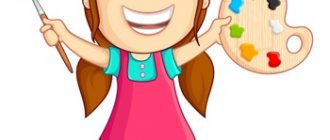General underdevelopment of speech, or GSD, is a systemic disorder of speech activity in which its semantic and sound components - phonetics, vocabulary and grammar - are incorrectly formed.
Until the age of 3–4 years, children “have the right” to speak as they can and want. But if your son or daughter, even after reaching this age, does not fully use speech as a means of communication, you should consult a doctor - a neurologist or speech therapist. If there is a problem, it is better to diagnose it in preschool age and teach the child to speak correctly. Otherwise, in the future, OPD promises him big problems in social and personal terms: difficulties in mastering writing and reading, the school curriculum as a whole, retardation in mental and mental development, personality disorders.
What does OHP mean and its symptoms?
Here are general signs that may indicate underdevelopment of speech in a child:
- said the first words at 3–4 years old, and in more severe cases at 5 years old;
- speaks illiterately, incoherently and incomprehensibly, the phonetic design of speech is low;
- The baby understands the words addressed to him, but cannot fully express his thoughts.
Depending on the severity of OHP, it is divided into 4 levels.
Level 1 violation is the most severe. The child either does not speak at all or speaks individual sounds or syllables.
With a level 2 illness, the baby, although he speaks at an everyday level, is illiterate, pronounces sounds incorrectly, and his vocabulary is small.
With speech underdevelopment of the 3rd level, the child has developed phrasal speech, but there is lexico-grammatical and phonetic underdevelopment.
The easiest is level 4. The baby communicates fully verbally, but there are still some problems.
Next, we’ll talk about the characteristics of each level of OHP in children in more detail.
Diagnostics of speech development of 2-3 year old children
It is easier for parents to evaluate the development of their own child by comparing him with his peers. But this is an erroneous approach, since each child has his own speed of learning the world, which is most convenient for him. To know whether the child’s level of development meets the norms, you need to compare it with the fact that at two or three years old a child should be able to:
- Understand simple sentences, questions and requests on everyday topics.
- Say hello and goodbye.
- Make sentences of 2-4 words.
- Memorize new words from songs and short rhymes.
- Formulate simple requests (for hands, for a drink, for a potty).
Degrees of speech underdevelopment and their characteristics
Depending on the depth of the lesion, OHP can manifest itself in different ways - from minor deviations to complete absence of speech.
Level 1: speech is practically absent
You don’t need to be a doctor to notice problems with speech development in a child. He uses babble, sounds, the first syllables of words. He speaks his “own” language; one word can mean several things.
Instead of words, the baby actively expresses his thoughts and desires with gestures and facial expressions, and is always appropriate and correct.
The child does not speak in simple sentences; at best, he uses two amorphous words, for example, “woof bee-bee” - the dog is driving a car.
The passive vocabulary is well developed - the baby understands speech addressed to him. But the active vocabulary is poor, phonemic hearing is not developed - the child cannot pronounce words that consist of several syllables, and says them in his own way: “abas” instead of “bus,” for example.
Level 2: presence of commonly used words
This is the main characteristic of speech underdevelopment of this degree. There are words in speech, although there are not very many of them and the child pronounces them incorrectly. But a grammatical connection between words is already beginning to form.
The kid distorts the name of a certain object, and everywhere. For example, instead of “apple” he says “lyabako”.
The child does not know the shapes, parts of objects, and cannot combine them into groups (dishes, toys, clothes).
The baby pronounces most sounds incorrectly, does not coordinate words in simple sentences, often misses prepositions, and shortens words of several syllables.
But in simple sentences he can correctly name objects and their actions in the plural (for example, goes - go). If you ask your baby to tell you what he sees in the picture, he may come up with a coherent story, albeit a very limited one.
Level 3: violation of grammar and phonetics
The child has a large active vocabulary; he speaks in detailed sentences, but the development of the grammatical and phonemic components of speech suffers.
Parents understand the baby well, but when communicating with others they need a “translator”. The baby pronounces isolated sounds well, but his speech is still unclear. If it is difficult for him to pronounce a sound, he replaces it with an easier one. This is especially true for affricates, whistling, sonorant and hissing sounds.
Complex and complex sentences still cause difficulties, but the child is confidently moving towards success. But little-used vocabulary is still inaccessible to him - in his speech he uses words of everyday meaning that he constantly hears around.
The child constructs phrases and can compose a story, although he still forms sentences with errors. But errors in word agreement do not occur all the time. More often, the child makes mistakes when coordinating nouns and numerals: “many cats - many cats.”
He does not always pronounce complex words correctly; he cannot name words that begin with a specific letter.
Level 4: practically a variant of the norm
Speech underdevelopment is not noticeable, but taken together the symptoms make it difficult for the child to study at school - it is more difficult for him to learn to write and read. Therefore, it is imperative to eliminate the symptoms of OHP. Although this form of disorder is quite rare.
The child periodically pronounces complex words incorrectly - skips syllables, replaces or swaps sounds.
Articulation and diction suffer - speech is unclear, slightly slurred, and the child does not always use words as intended, because he does not understand or confuses their meanings. This is especially true for the characteristics of objects (for example, tall - long, low - short).
Another problem area is the formation of words using a suffix; errors remain in the agreement of nouns and adjectives and the plural.
Critical thinking is developed: if a child is given two answer options, he will choose the correct one.
Exercises for speech development
"Pipe and Whistle"
The child is surrounded by a world of various sounds. If you knock on this little thing, you will get one sound, but if you blow on this pipe, then a completely different sound will come out. When making sounds, the baby simultaneously trains breathing and learns the cause-and-effect relationship (blowed into a pipe - received a sound). It's best to start with a simple whistle because you just need to blow into it to get the sound out. For older children, you can use a pipe, which complicates the task and thereby makes it more entertaining and interesting for the baby.
"Wash"
It is best to do this exercise while washing your face in the morning, taking advantage of the kids’ favorite pastime - making faces in front of the mirror. You need to ask the baby, with his lips stretched out, to say “o”, “vo”, “mo”. Just 2-3 minutes is enough for this exercise.
"Who's next?"
The rules here are very simple: whoever lasts any vowel sound longer. You can also draw out some consonants. Children love to play this game with their parents.
"Repeat after me"
The game develops the articulatory apparatus and forms correct pronunciation. You need to read short rhymes to the baby, and he must repeat the last syllable after the adult. The kids came running - ra-ra-ra, ra-ra-ra. Leg higher, step bolder - ley-lay-lay, ley-lay-lay. We will see the leaves fall - pad-pad-pad, pad-pad-pad. Dear bunny, don’t be bored - tea-tea-tea, tea-tea-tea.
"Show off the bear"
The game develops speech and teaches how to navigate in space. It will require a soft toy (in this case, a bear). An adult should take the bear in his hands and in his voice tell the baby that he would really like to get to know the place where the baby’s family lives. Then you need to ask the child to take the bear around the house and show him all the interesting places. You can start from the kitchen, where the baby should “take” the toy. Using the voice of a toy, an adult should ask what the names of kitchen utensils and furnishings are, and with his paw point to the table, stove, refrigerator, etc. The bear should ask why they are needed, and the baby should answer these questions. Then you can go around the other rooms.
"More words"
The game helps develop speech and teaches how to compose long words. Together with your child, you need to try to indicate the property or sign of an object in one word. For example, if dad has brown eyes, then he is brown-eyed, and if a bunny has long ears, then he is long-eared.
"Guess the Animal"
The game develops the articulatory apparatus, speech, and introduces the baby to the world of animals. It will require cards with images of animals and a friendly company. Mix the inverted cards and place them on the table. Each player takes out a card in turn and voices the animal depicted there, while the rest must guess who he was describing.
"Finish the word"
The game develops attention, memory and speech. You need to ask the child to complete the word spoken by the adult: “magazin”, “dorog-ga”, “kolo-bok”. If the baby doesn’t guess, then you can point him to the named object.
"Animal Voices"
This game develops articulation, speech and introduces the animal world. You need to prepare animal toys or cards with their images. The child needs to be shown toys or cards and allowed to look at them carefully, while telling him where the animal lives and what it eats, and what sounds it makes. It would be great to take your child to the zoo or use recordings of animal voices. Then you can conduct the final lesson. When the child sees the card, he is asked to name the animal depicted and remember the sounds it makes:
- rooster - crows (crow);
- goose - cackling (ha-ha-ha);
- duck - quacks (quack-quack);
- turkey - kuldyk (kuldy-kuldy);
- crow - croaks (kar-kar);
- sparrow - tweets (tweet-tweet);
- eagle owl - hoots (hoo-hoo);
- cat - meows (meow-meow);
- dog - barks (woof-woof);
- goat - bleats (me-e-e);
- wild boars, pigs - grunt (oink-oink);
- cow - moos (moo-oo);
- horse - neighs (e-go-go);
- donkey - brays (ey-ey);
- mouse - squeaks (pi-pi-pi);
- frog - croaks (kva-kva);
- tiger, lion - roars (r-r-r);
- elephant - trumpets (tu-u-u);
- bee - buzzing (w-w-w).
You should not ask your child about all animals at once.
"My phone rang"
The game replenishes vocabulary and develops speech. It simulates a conversation on the phone, the function of which can be performed by any object, for example, a piece from a designer, a stick, a cube. The parent and child should take turns pretending to be talking on the phone. The elder asks simple questions on his own behalf, and the child answers. Then they change roles. You can also talk to your baby on behalf of the animal or toy.
Reasons for the development of OHP in children
Speech development disorders can have different causes. Let's highlight the following groups:
- Intrauterine development. Infections in the mother during pregnancy, toxicosis;
- Complicated childbirth. Injuries during childbirth, various pathologies;
- Health status of the newborn. Diseases of the central nervous system and traumatic brain injury in infancy can also cause the development of OHP;
- Social factors. Unfavorable family environment. For example, parents did not work with the baby, did not teach, did not develop.
In some cases, OHP in children develops against the background of intellectual or hearing impairments.
Runs
Walks on tiptoes Throws a ball over his head Grabs a rolling ball Stands on one leg for a short time while maintaining balance Carries an object a short distance Walks down (up) stairs Jumps in place on two legs Climb over obstacles Pedal a tricycle Development of fine motor skills Holds two objects in one hand Holds a pencil and draws strokes with itComprehensive diagnosis of the disease
It is important to involve different specialists in diagnosing speech underdevelopment. This is necessary to identify the cause of the disease. After all, it is important to treat it, and not the symptoms.
First of all, a neurologist, speech therapist, and neuropsychologist look at the baby. In some cases, you may need to consult a surgeon, dentist, otolaryngologist, or psychoneurologist.
But the leading role is given to the neurological examination. The doctor will assess the state of the nervous system and the location of the lesion - the form of the speech disorder depends on it. In conclusion, the neurologist indicates the cause of the disorder, its form, and focuses attention on the primary problem areas. All this data is subsequently used in diagnosis and correction by a speech therapist.
After consulting a neurologist - and in some cases other specialized specialists - the child is referred to a speech pathologist-speech pathologist. He studies the conclusions of his colleagues, supplements the anamnesis with the words of the parents, and then examines the child’s speech apparatus, studying the features of his sound pronunciation.
Then the speech therapist communicates with the little patient. In the process of communication, he assesses the degree of development of the child’s speech: whether he can express thoughts coherently, speak meaningfully, and competently construct a story.
Based on the examination, the speech therapist determines the form and degree of OHP and plans treatment.
Correction of general speech underdevelopment
The correction program depends on the cause of the disease. For example, if OHP has developed against the background of dysarthria, you first need to eliminate problems that are associated with the innervation of the speech apparatus; for sensory alalia - to develop phonemic hearing.
In any case, treatment is carried out in a complex manner. In case of speech underdevelopment of levels 1–2, a speech therapist and a neuropsychologist or neurologist work with a small patient.
Doctors carry out correctional work in several directions at once:
- Develop imitative activity. The baby repeats sounds that he heard earlier;
- Train hand motor skills. The development of speech also depends on the dexterity of small hands. Specialists conduct classes with the baby that develop coordination of speech with movement, general and fine motor skills;
- They train the articulatory apparatus - the muscles of the lips, tongue, cheeks. This is facilitated by speech therapy exercises, articulation and breathing exercises.
The program also includes exercises for memory training and development of speech understanding. The goals of the lessons depend on the degree of impairment.
Correction of OHP in children of the 1st level
The goal is to teach the child to understand speech addressed to him, to activate the baby’s independent speech activity, memory, thinking and attention. The grammatical component of speech is important. But the phonetic design does not matter yet.
Correction of level 2 violation
The goal is to develop speech activity in the baby, teach him to understand speech, teach phrasal speech, and work on sound pronunciation (sounds that the child pronounces incorrectly or does not speak at all).
In case of ODD in children of 1st - 2nd degree, education is possible only in specialized schools for children with severe speech development disorders.
Correction of level 3 violation
The goal is to develop coherent speech in the child, improve its lexical and grammatical components, and consolidate the correct pronunciation of sounds and phonemic perception. At this stage, it is important to prepare the baby to master literacy. Children with this diagnosis study in correctional classes at a regular school.
Correction of level 4 violation
The goal is to bring the child’s speech to the age norm so that he does not have problems with learning at school. The speech therapist pays attention to improving and consolidating correct sound pronunciation, lexico-grammatical and phonemic components of speech. The speech therapist develops developed phrasal speech and grapho-motor skills, and also teaches the child the basics of writing and reading. Children with speech impairments of the 4th degree study in regular classes.
In addition to speech therapy work, a neurologist can prescribe drug therapy, transcranial magnetic stimulation, massage, and treatment with an osteopath.







